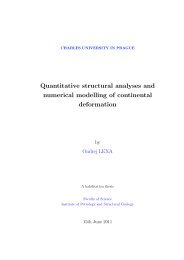PhD. thesis - Univerzita Karlova
PhD. thesis - Univerzita Karlova
PhD. thesis - Univerzita Karlova
Create successful ePaper yourself
Turn your PDF publications into a flip-book with our unique Google optimized e-Paper software.
Figure 5: Structural elements from studied area. a) Poles to main Alpine metamorphic anisotropy showing girdle<br />
distribution around the axis sub-parallel to hinges of late Alpine folds – 116 measurements; b) orientation of<br />
stretching lineation – 68 measurements; c) distribution of poles to main fracture systems developed in studied area<br />
(Hók et al., 2001) overlaid by shaded areas indicating ‘apparent’ fold sections in which shear-band geometry can<br />
be observed; d) rose diagram of main fracture directions in studied area (Hók et al., 2001). Note that a main<br />
maximum of fracture orientations coincides with orientations of apparent fold sections. All data are plotted on<br />
Schmidt net and projected from lower hemisphere. In a) and b) the contour levels are even multiples of standard<br />
In order to evaluate the probability of encountering oblique sections with shear-band<br />
like geometry in a particular field area, we need to identify the dominant geometries of the<br />
small-scale folds and moreover, we have to understand the distribution of surfaces on which the<br />
structures are observed. It should be pointed out, that the majority of observations are from<br />
natural rather than man made outcrops, where the orientation of the exposed surfaces is<br />
controlled mainly by fractures (typically joints). In addition, sections that are sub-parallel to the<br />
lineations are specifically selected as being appropriate for the study of kinematic indicators.<br />
We plotted the range of sections with shear-band like geometry, the range of naturally occurring<br />
fractures and the distribution of lineations on a stereographic projection (Fig. 5c), which shows<br />
that there is a high probability of systematically observing oblique sections across the<br />
47







